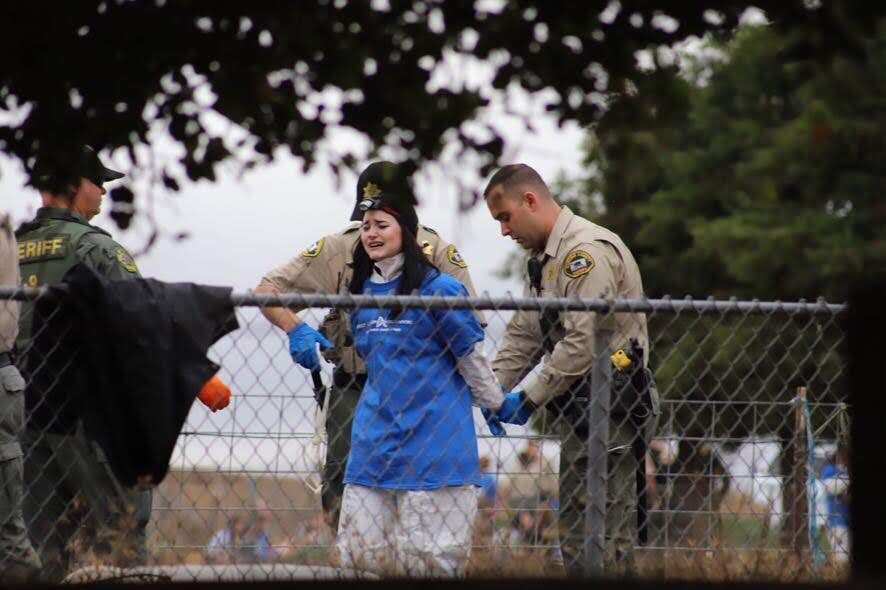 |
| Arrest during a protest in Petaluma. Photo credit: DxE. |
Whether or not the necessity defense applies, or should apply, to open rescue, is a doctrinal legal question. As a law and society scholar, I ask myself questions about the interaction of the law with people, institutions, and movements. Because I have a special interest in social movements, I ask myself: How do animal rights activists understand and perceive the role of the criminal process in their lives? The extent to which the law is present in people's lives is its own field of study, known as legal consciousness.
Part IPart II
In their classic book The Common Place of Law Patricia Ewick and Susan Silbey present three schemas of relating to the law in everyday lives: before the law, with the law, and against the law. People's experience of the law extends farther than their involvement in official legal institutions, such as calling the police on someone, visiting a courtroom, or hiring a lawyer. While some scholars have supported the idea that the law is present everywhere in everyday lives (see Austin Sarat's study of the welfare poor) others have found people so busy surviving that they are not even conscious of the law or so skilled and privileged that they can structure even oppressive legal experiences, such as incarceration, as "games", "experiments", or "educational experiences", outside of the legal framework.
But what about social movements? An entire area of study is devoted to this question, looking at the way advocates and activists perceive the law. Idit Kostiner, who studied social justice activists, found that they see the law's value through three main schemas: instrumental (obtaining rights), political (galvanizing activists and organizing) and cultural (relying on the law to change perceptions.) In expanding the understanding of legal consciousness beyond merely obtaining rights, she follows Michael McCann, who argues that legal mobilization helps social movements even if they don't get exactly what they advocate for, because it provides them with a framework that is helpful for advancing their cause.
How do animal rights activists map onto all this? The animal rights movement operates within the constraints of a legal order that completely ignores, or negates, what the movement believes in. The law sees animals as property, and much of our economic system is structured around the exploitation of animals (often in conjunction with the exploitation of others.) This could make the activists very cynical about the law. Indeed, a beautiful interview-based study conducted by Erik Fritsvold found that radical environmental activists tend to perceive their relationship to the law as "under the law" and their primary engagement with it through lawbreaking.
Fritsvold's subjects and mine are not that different from each other. The activists he studies also define their actions as direct action, which, according to Noel Sturgeon, is "a series of 'actions' engaged in by groups that organize themselves in a decentralized, nonhierarchical manner . . . which use a participatory, democratic, decision-making process . . . and which prefer direct action to institutionalized, electoral, or interest-group politics. Frequently, such groups are involved in civil disobedience, that is, the principled breaking of the law in the process of political protest."
For direct action environmentalists, the law is an instrument of injustice to fight against. This schema differs from Ewick and Silbey's category of "against the law", because to the activists, "the law veils the illegitimacy of the existing social order and actively represses dissent. Against the Law observes that the law often fails as an asset to achieve justice; Under the Law views this failing as intentional and perceives law as an active agent of injustice."
Nonetheless, it seems that animal rights activists in general, and DxE activists in particular, somewhat differ from Fritsvold's interviewees. Helena Silverstein's wonderful 1996 book Unleashing Rights about animal rights activism shows that, despite thorny philosophical difficulties with the concept of "rights", which activists saw as anthropocentric, they did not shy from employing this concept when it served their purpose--or from hiding it from sight when it did not. Indeed, my own subjects, when planning open rescues, display some important markers of legal sophistication. Until fairly recently, DxE was led by Wayne Hsiung, an attorney and former legal academic, who is very well-versed in the legal status of animal rights nationally and internationally. Other members of DxE are lawyers, law students, or aspiring law students, and very well aware of the role the law plays in their activism.
Important questions regarding DxE's legal consciousness involve how open rescue operations are planned. In anticipation of a direct action, do activists reach out to legal authorities to report animal cruelty? Do they expect the authorities to intervene, and on whose behalf? When entering the facility, do activists try to seek detection, avoid detection, or a mix of both? If and when they encounter the facility owners or workers, do they attempt to alert the media or resolve things quietly? When encountering law enforcement in the field, how do they interact with them?
Answers to these questions are strategically tricky, because there are two different legal outcomes looming ahead: the short-term one consists of a possible arrest of the activists, perhaps followed later by a court case. The long-term outcome consists of changing the laws of the animal products industry and, perhaps in our lifetime, even eradicating it. What activists might do to promote one of these outcomes could harm the other, and requires careful thinking ahead. It is also the case that, even with carefully planned actions, unexpected circumstances can change the nature of the encounter and enhance, or diminish, the clash with law enforcement. I plan to look at these questions as well.
The next post in the series will address preparations and strategies for criminal trials, involving both strategic and tactical considerations.
Part IV
Part V
No comments:
Post a Comment